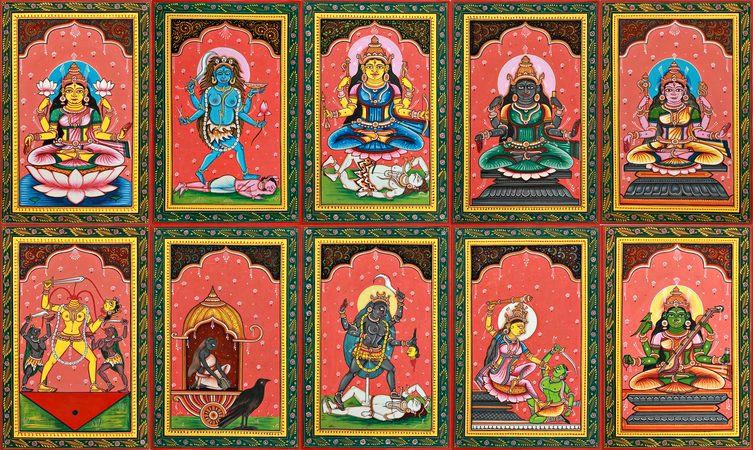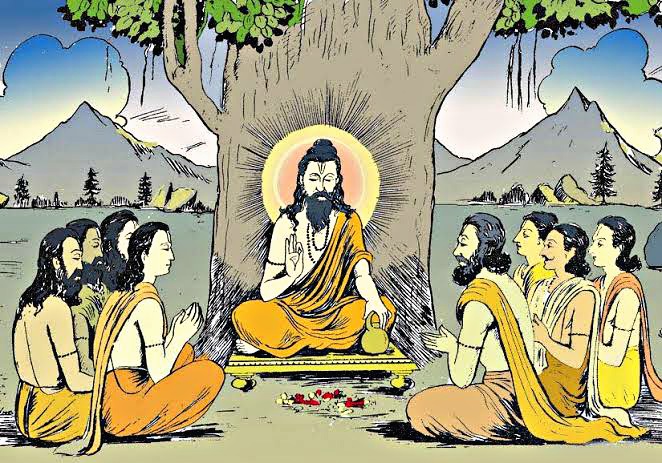In Hinduism, the Goddess or Feminine form is worshipped in many ways & is given utmost importance. Navaratri is one of the most auspicious festival in Hinduism. As we have seen that there are different days or months, which are connected to worship particular gods/goddesses likewise; Navratri is the festival which is connected to worship goddess only. As you have read in the previous article that, according to the Hindu Scriptures, there are total five (05) Navratris viz. Pausha, Magha, Chaitra, Aashadha & Ashwina Navratri. Each Navaratri holds a special significance & it is celebrated by worshipping the nine different forms of The Adi Shakti (आदि शक्तिः) (Primordial Form of Goddess).
Generally, only three Navaratris are known & celebrated by the people, which falls in the month of Pausha, Chaitra & Ashwina. But apart of these three Navaratris there are two more Navaratris which are not much prevalent & it is known as Gupt Navratri. First Gupt Navaratri is in the bright fortnight of the Magha month & second Gupt Navaratri is in the bright fortnight of the Aashadha month. Magha Navratri is celebrated in the month of Magha (माघः). Magha Navratri is also known as Maghi Navratri & Gupt (secrete) Navratri. This Navaratri is celebrated from the first day of the bright fortnight of the Magha month (माघः शुक्लपक्षे प्रतिपदा) till the ninth day of the bright fortnight of the Magha month (माघः शुक्लपक्षे नवमी). During this Navaratri there also occurs two more festivals, Vinayak Choth & Vasant Panchmi, about which we will discuss in an upcoming articles.

Aspects of Magha Navratri (माघः नवरात्री) -
This Navratri is more prevalent among the Tantrikas (तांत्रिकः) & Sadhakas (साधकः). Tantrikas (तांत्रिकः) are those who have the super powers & performs more Tantra Sadhna (तंत्र साधना ) (i.e., worshipping & performing the principles of Tantra) to gain more such powers & these Tantrikas are known as occultists in English. Sadhakas (साधकः) are those who are more inclined to Spiritual practices & perform Anushthanas (i.e., performing the religious rites) (अनुष्ठानम्) to increase more spiritual powers to attain the Liberation (मोक्षः). According to the Devi Bhagwatam these the Ten Mahavidyas are worshipped during this Gupt Navratri. These Ten Mahavidyas are ten forms of Goddess & they are; Kali, Tara, Tripura Sundari (Shodashi), Bhuvaneshwari, Tripura Bhairavi, Chinnamasta, Dhumavati, Bagalamukhi, Matangi & Kamala. Not only Tantrikas but Sadhakas & many other worships these ten forms during Gupt Navratri.
As this Navratri is associated to the Ten Mahavidyas this Navratri is more important & significant to the Tantrikas & Sadhakas. Those who knows the importance of this Navratri & perform the rituals during this Navratri, attain increment in their mystical powers during this Navratri. The reason that this Navratri is known as Gupt Navratri is that, one should worship goddess during this Navratri in secrecy without disclosing about performing rituals & worships thus, by performing it in secrecy one attains the fruitful results. According to the Scriptures, Gupt Navratri has been described as the worshipping period for attaining secret powers (गुप्तः सिद्धः).
Magha Gupt Navaratri is also referred to as Gayatri Shishir Navratri as it falls in the winter months between January & February. This Navratri is predominantly celebrated in the northern parts of India; especially in Punjab, Haryana, Himachal Pradesh, Uttar Pradesh & Uttarakhand. Gupt Navratri is celebrated with the primary objective to please the Adi Shakti (आदि शक्तिः) (Primordial form of the Goddess) to bestow prosperity, wealth, knowledge & positivity in materialistic as well as spiritual life. By worshipping goddess during this Navaratri, she eliminates distress & negativity from life. This ritualistic worship of Adi Shakti is performed daily for nine days & nights not only by worshipping Ten Mahavidyas but also with the recitation of the Durga Saptashati.
According to the Scriptures, God Shiva offered & taught the Tantra Vidya (तंत्र विद्या) to Adi Shakti during the month of Magha & Aashadha in a secret cave & because of the same reason these two Navaratris are known as Gupt Navratri & are to be performed in secrecy.

Historical Significance of Magha Navratri (माघः नवरात्री) -
According to Scriptural legend, once Rishi Shrungi was giving darshan to his devotees & there a woman who was in great trouble came from the crowd & started narrating her griefs to the sage. She said that her husband is always surrounded by bad deeds due to which he is not able to perform puja rituals also, her husband does not accompany or allow her to perform any kind of religious puja or let her worship any gods or goddesses. Disturbed by her husband's actions, the woman told sage Shrungi that she could not even offer the share of food for the sages also she said that her husband consumes meat, drinks alcohol & gambles, but she is the devotee of goddess & want to worship her & rectify the karma of her husband & her family with devotion.
Sage Shrungi is pleased with her behaviour & explained the remedy to her that, everyone knows Pausha, Chaitra & Shardiya Navratri, but Navratri of Magha & Aashadha month is called Gupt Navratri. Goddess should be worshiped in secret during these nine days. The sage told that 9 goddesses are worshipped during the Navratri & 10 Mahavidyas are worshipped during Gupta Navratri. The name of the main goddess form of Gupt Navratri is the goddess Sarvaishvaryakarini (सर्वैश्वर्यकारिणी). Worshiping the Mother Goddess during this Navratri can make a devotee’s life successful. The sage told that if a person who is greedy, addicted, non-vegetarian or not performing rituals, such person when worships the goddess during Gupt Navratri then all the sins of his life are forgiven. She agreed to sage Shrungi & the woman worshiped the Goddess during this Gupt Navratri as prescribed by the sage & later her sinful husband started following the religious path by leaving all the bad deeds & her family lived with peace & happiness. Such are the powers of these Gupt Navratris.

Ritual ceremony of Magha Navratri (माघः नवरात्री) -
During Magha Gupt Navratri, the puja rituals are not done in the morning like the other Navratris but it should be done during evening or night time. After cleaning the puja area, one should decorate the place of worship or puja & begin their preparations. Kalash grown with barley is kept in front of the idol or photo of the goddess at auspicious timing & another kalash with a raw coconut is kept over it & the installation (घटस्थापना) ritual is done. An idol of Goddess is decorated with red bindi, red bangles, saree, etc. Later, a 16 Worshipping Practices (षोडश उपचारः) puja is done every day from the day one till the ninth day during this Navratri. The one who take up this puja ritual follow strict fast where they only eat one meal after finishing puja rituals & offering food to Brahmin. Few devotees also observe partial fasting by eating fruits & other dairy products only.
Devotees recite Durga Shaptashati Path & also take up an Anushthana (i.e., performing the religious rites) (अनुष्ठानम्) which is generally one mantra to be recited every day in a particular number for nine days during this Navratri. Some devotees also ignite Aakhand jyot (a long-lasting lamp) of ghee in front of goddess to acquire more blessings. When devotee do this puja ritual in secrecy with a pure heart then Goddess fulfils all their wishes. Puja rituals or only Mantra Japa (मंत्र जपः) during Magha Gupt Navratri provides meritorious fruits & the goddess bestow her divine blessings to their devotees if the rituals are followed with complete faith. After worshiping for nine days during this Navratri, girls are served a feast on Ashtami & Navami. Sometimes the puja rituals are almost same as the other Navratri puja rituals but, only the difference is that one must not disclose it to others, it is done secretly & during evening or night time to obtain more benefits.
Thus, Goddess is the most vital part of Sanatana Dharma & is worshipped with great respect as she is the Life-giver & nurturer of this universe. Hindus, not only worship goddesses but, we also worship & respect every female as we consider her as a part of Adi Shakti. Gupt Navratri holds a very vital part of our religion & mainly has its special place among the Tantrikas & Sadhakas. So, Gupt Navratris has more significance than the other Navratris.
कार्तिकः शुक्लपक्षे ०४, २०७८
